Excerpts from Jim Conrad's
Naturalist Newsletter
Entry from field notes dated September 1, 2023, taken in Los Mármoles National Park in the Eastern Sierra Madre mountains, Hidalgo state, MÉXICO, along steeply climbing road heading eastward out of town of Trancas {on maps designated "Morelos (Trancas)"} toward Nicolás Flores; juniper/pine forest on limestone bedrock; elevation ~2,300m (~7,550ft); ~N20.80°, ~W99.25°
ADDER'S-MOUTH FLOWERING

The above one-leafed plant emerged about 15cm high (6inches) from a mat of mosses and dried-up ferns in thin soil atop a roadcut through limestone. Here's what the structure at the stalk's tip looked like, seen from above:
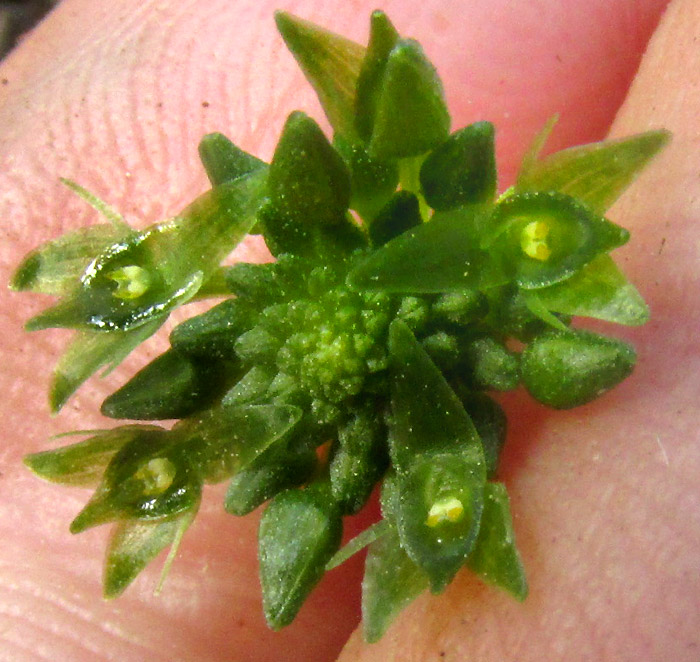
It's an inflorescence of green flowers. The flower cluster is immature, though, with only four blossoms along the margin open for pollinators. The inflorescence's interior is composed of closed flower buds which are smallest and least developed at the flower cluster's center. Blossoms start flowering along the margin, then buds gradually open closer and closer to the center, until the center buds become the newest flowers; this provides the plant with a longer flowering period.
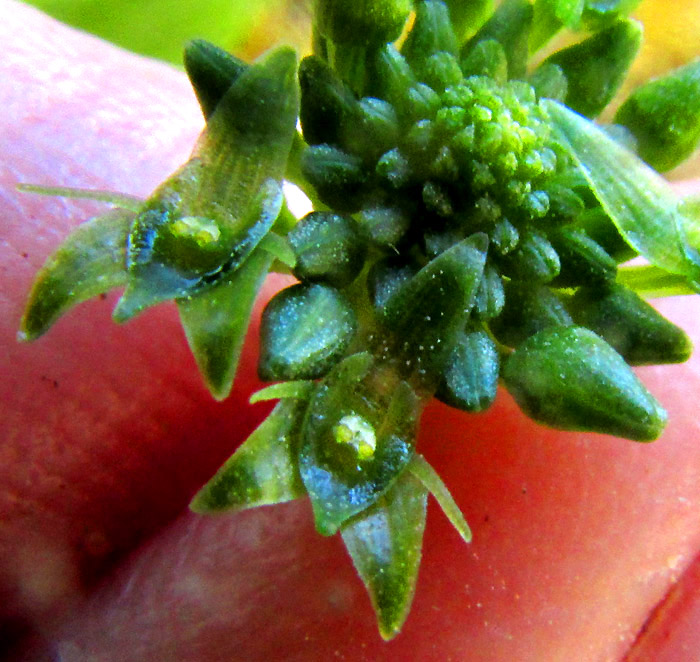
Closer up, it's apparent that these are orchid flowers, though much smaller and simplified ones. If the flower is imagined as human-shaped with a pointy head, and legs and arms spread as if barring a door, the head and fat legs are sepals, the slender arms are petals, and the broad, flat, heart-shaped part in the middle, with two ear-like lobes at the top, is the labellum, or lip. The small white item with two yellow eyes is the column and the yellow eyes are pollinia, which are waxy packages of pollen. Presumably, the depression visible below the pollinia is glistening with nectar. Wikipedia provides a Pollination of Orchids page explaining how the various parts function. Here's how the rounded leaf base connects with the stem:
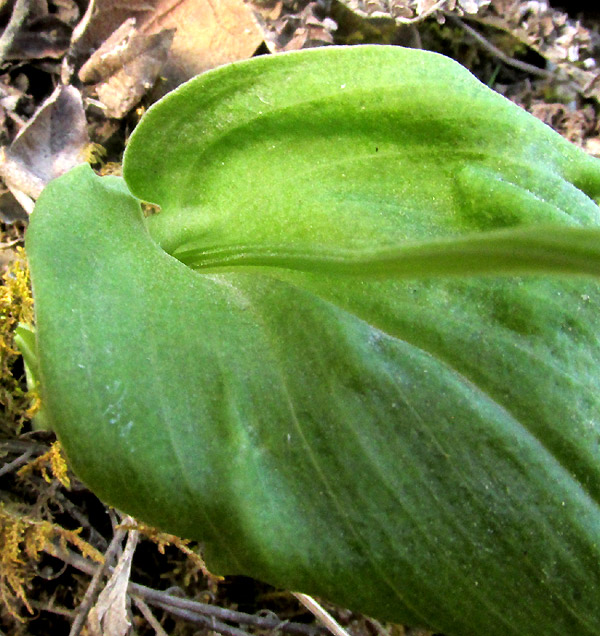

At the right, the stem enters the moss mat. Technically, this species is described as having its stem swollen at the base to form an egglike pseudobulb 5-15mm in diameter. The picture doesn't show that so the pseudobulb must be hidden by the moss; I didn't want to bother the orchid just to expose it.
The Orchid Family, the Orchidaceae, is the second largest family of all flowering plants, with about 880 genera and something like 26,000 known species worldwide, so identifying unlabeled wild ones can be a challenge. However, our roadcut plant is so unusual that it stands out. Among its basic distinguishing features are: growing on the ground, not on trees; producing flowers and leaf at the same time; its single, somewhat fleshy leaf bearing no large, conspicuous, green, bulb-like pseudobulb at its base; the inflorescence flattish when young and elongating upward only a little as it matures; individual flowers being green and not producing a spur behind them, and; the petals being proportionally very small and slender. These are general features of the mostly tropical genus Malaxis, with over 180 known species, the species in English often known as adder's-mouths.
The 2022 study by José Luis Villaseñor and others entitled "Riqueza y distribución de la flora vascular del estado de Hidalgo, México" lists nine Malaxis species for our upland central Mexican state of Hidalgo. Of those species, if your orchid's flowers group in a flat-topped or at least not slenderly elongated inflorescence with flowers all along its length, the lobes at the wide base of the flower's lip are rounded and not sharply pointed, and the lip itself is basically flat, not with three ridge-like crests along its length, you have MALAXIS BRACHYSTACHYS
In most literature Malaxis brachystachys still is referred to by its former name of Malaxis corymbosa. In English, usually it's known as the Huachuca Adder's-mouth because in the US it occurs only in Arizona's Huachuca, Santa Rita and Chiricahua Mountains. However, that's just a tiny portion of the species' distribution area, which expands from there southward throughout highland Mexico, all the way into Nicaragua; here we'll just called Adder's-mouth. It's described as living in shaded canyons and highland forests.
The NorthAmericanOrchidCenter.Org website says that fungus gnats and gall gnats pollinate the flowers.
In terms of how this species fits into the general biosphere, of course fungus and gall gnats are glad to have their nectar. Moreover, certain tiny predators are glad to eat the gnats, and larger predators eat those little ones, on and on. Plus, nearly all orchid species participate in a complex symbiotic association with fungal mycelia -- a mycorrhizal association -- which helps the orchid absorb minerals and water from the soil, as the orchid provides the fungus with carbohydrates formed during photosynthesis. Fungi are being found to be critical in many aspects of overall biosphere maintenance, so indirectly the orchid helps with that, too.
Entry from field notes dated September 2, 2023, taken in Los Mármoles National Park in the Eastern Sierra Madre mountains, Hidalgo state, MÉXICO; near ridgetop along road leading to Puerto de Piedra, which branches off the road between Trancas {on maps designated "Morelos (Trancas)"} and Nicolás Flores; limestone bedrock; elevation ~2,550m (~8,400ft); ~N20.81°, ~W99.23°
ADDER'S-MOUTH CAPSULE
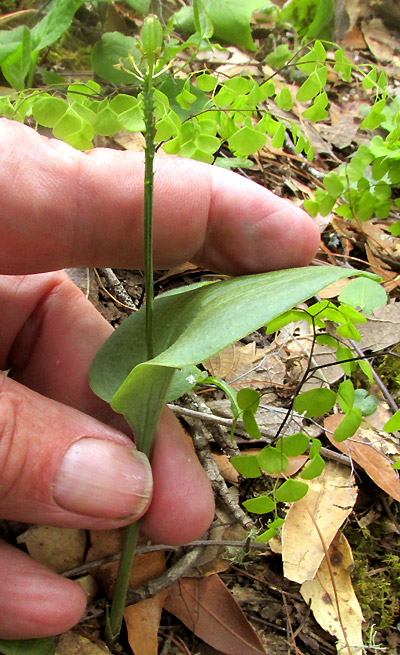 The day after the previous photos were made, a second plant was found maybe 1km to the east, shown at the right. This was on a steep, north-facing slope forested with oaks and pines. The ferns in the background are maidenhairs, Adiantum tenerum.
The day after the previous photos were made, a second plant was found maybe 1km to the east, shown at the right. This was on a steep, north-facing slope forested with oaks and pines. The ferns in the background are maidenhairs, Adiantum tenerum.
The plant bore a single capsule-type fruit at its top. In the picture we can see how the inflorescence rachis elongated as more flowers opened. All the flowers which originally blossomed at the flat-topped flowering head's periphery fell off without producing fruits.
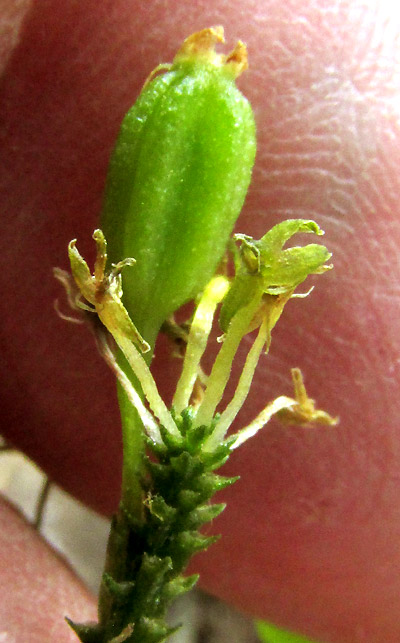
The capsule at the left is still immature. It's surrounded by fading, drying-out flowers which apparently won't produce any capsules. The Flora of North America, referring to fruiting Malaxis species in general, remarks that the previous year’s fruiting stem and capsules frequently persist into the next year's flowering period. Since our plant still bears this season's blossoms, the impression is given that, if the capsules often remain on the stem into the next season, Malaxis capsules may be slow to mature, and/or disperse their seeds over a long period. Mature capsules are reported to reach 12mm in length (½ inch).
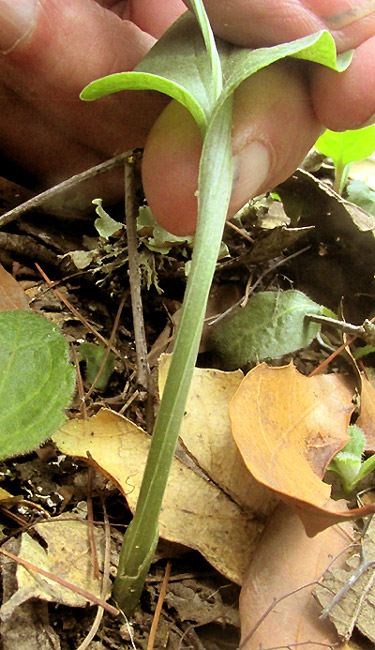
The picture at the left confirms that with age no second leaf develops; some Malaxis species bear two leaves.
The matter of our plant producing just a single capsule is put in perspective by remembering that Orchid seeds are very small -- often referred to as dust-like -- so a small capsule produces a prodigious number of seeds. The study by Joseph Arditti and Abdul Karim Abdul Gani of 2000 entitled "Tansley Review No. 110 Numerical and physical properties of orchid seeds and their biological implications," reports a capsule produced by Malaxis monophyllos filled with 1,572 seeds. Capsules of Malaxis species are relatively small; their seed number can be compared to 500,000 to six million in much larger Cattleya capsules.
The advantages of producing large numbers of seeds are balanced with the disadvantage that such small seeds carry hardly any food for germinating plants to use before they can begin photosynthesizing. When such tiny seeds reach their landing spot, environmental conditions must be close to perfect, or germinating seeds will die.
Add to that the fact that during these earliest stages of orchid plant development they rely entirely on mycorrhizal fungi for all their nutrients, including carbon. If the right fungus isn't present, the orchid can't survive. With climate change stressing most biological communities, often causing the collapse of species critically important to the highly evolved orchids -- mycorrhiza, specific pollinators, specific plant hosts of parasitic orchid species -- these are hard days for orchid species.
The Smithsonian Environmental Research Center on its "Orchids, Fungi & Symbioses" page reports that more than half of native North American orchids have been listed as threatened or endangered in some part of their home range. With human population densities higher in Mexico, and there being less protection of natural resources here, it can be guessed that Mexico's orchids face even a bleaker future.